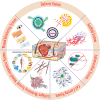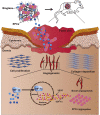Nanobiotechnology: Applications in Chronic Wound Healing
- PMID: 35898438
- PMCID: PMC9309282
- DOI: 10.2147/IJN.S372211
Nanobiotechnology: Applications in Chronic Wound Healing
Abstract
Wounds occur when skin integrity is broken and the skin is damaged. With progressive changes in the disease spectrum, the acute wounds caused by mechanical trauma have been become less common, while chronic wounds triggered with aging, diabetes and infection have become more frequent. Chronic wounds now affect more than 6 million people in the United States, amounting to 10 billion dollars in annual expenditure. However, the treatment of chronic wounds is associated with numerous challenges. Traditional remedies for chronic wounds include skin grafting, flap transplantation, negative-pressure wound therapy, and gauze dressing, all of which can cause tissue damage or activity limitations. Nanobiotechnology - which comprises a diverse array of technologies derived from engineering, chemistry, and biology - is now being applied in biomedical practice. Here, we review the design, application, and clinical trials for nanotechnology-based therapies for chronic wound healing, highlighting the clinical potential of nanobiotechnology in such treatments. By summarizing previous nanobiotechnology studies, we lay the foundation for future wound care via a nanotech-based multifunctional smart system.
Keywords: cell-carrying systems; chronic wound healing; nanobiotechnology; scaffold systems; stimuli-responsive systems.
© 2022 Jiang et al.
Conflict of interest statement
The authors report no conflicts of interest in relation to this work.
Figures




Similar articles
-
[Clinical application of negative-pressure wound therapy in split-thickness skin grafting at hard-to-fix sites].Zhonghua Shao Shang Za Zhi. 2020 Jul 20;36(7):528-533. doi: 10.3760/cma.j.cn501120-20200224-00086. Zhonghua Shao Shang Za Zhi. 2020. PMID: 32842398 Chinese.
-
Challenges and opportunities of pH in chronic wounds.Ther Deliv. 2019 Nov;10(11):719-735. doi: 10.4155/tde-2019-0066. Epub 2019 Dec 2. Ther Deliv. 2019. PMID: 31789109
-
Wound care in venous ulcers.Phlebology. 2013 Mar;28 Suppl 1:79-85. doi: 10.1177/0268355513477015. Phlebology. 2013. PMID: 23482540 Review.
-
OUTCOME OF FOAM VERSUS GAUZE DRESSINGS IN NEGATIVE PRESSURE WOUND THERAPY FOR THE MANAGEMENT OF ACUTE TRAUMATIC WOUNDS WITH SOFT TISSUE LOSS AT KENYATTA NATIONAL HOSPITAL.East Afr Med J. 2012 Jul;89(7):230-40. East Afr Med J. 2012. PMID: 26845802 Clinical Trial.
-
Emerging treatment strategies in wound care.Int Wound J. 2022 Nov;19(7):1934-1954. doi: 10.1111/iwj.13786. Epub 2022 Mar 17. Int Wound J. 2022. PMID: 35297170 Free PMC article. Review.
Cited by
-
Preparation of Ultra-Small Copper Nanoparticles-Loaded Self-Healing Hydrogels with Antibacterial, Inflammation-Suppressing and Angiogenesis-Enhancing Properties for Promoting Diabetic Wound Healing.Int J Nanomedicine. 2023 Jun 19;18:3339-3358. doi: 10.2147/IJN.S399933. eCollection 2023. Int J Nanomedicine. 2023. PMID: 37361387 Free PMC article.
-
High-throughput screening-based design of multifunctional natural polyphenol nano-vesicles to accelerate diabetic wound healing.J Nanobiotechnology. 2024 Nov 21;22(1):725. doi: 10.1186/s12951-024-02950-2. J Nanobiotechnology. 2024. PMID: 39574119 Free PMC article.
-
The Effect of Platelet Fibrin Plasma (PFP) on Postoperative Refractory Wounds: Physiologically Concentrated Platelet Plasma in Wound Repair.Tissue Eng Regen Med. 2024 Dec;21(8):1255-1267. doi: 10.1007/s13770-024-00665-x. Epub 2024 Oct 14. Tissue Eng Regen Med. 2024. PMID: 39400879
-
State-of-the-Art Review of Advanced Electrospun Nanofiber Composites for Enhanced Wound Healing.AAPS PharmSciTech. 2023 Nov 29;24(8):246. doi: 10.1208/s12249-023-02702-9. AAPS PharmSciTech. 2023. PMID: 38030812 Review.
-
Lignin-Based Nanoparticles as Both Structural and Active Elements in Self-Assembling and Self-Healing Multifunctional Hydrogels for Chronic Wound Management.Pharmaceutics. 2022 Nov 30;14(12):2658. doi: 10.3390/pharmaceutics14122658. Pharmaceutics. 2022. PMID: 36559153 Free PMC article.
References
Publication types
MeSH terms
LinkOut - more resources
Full Text Sources

